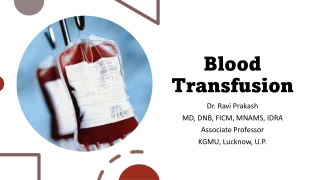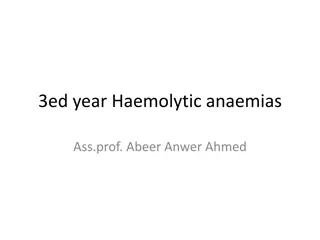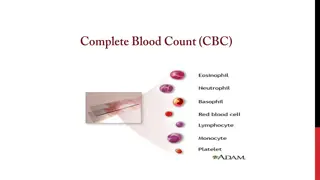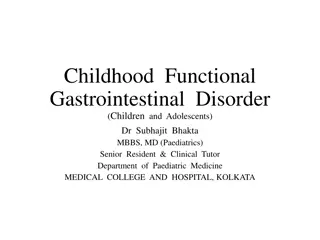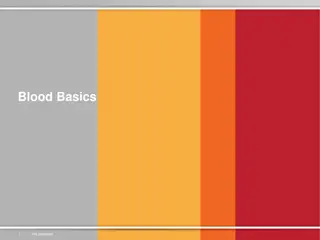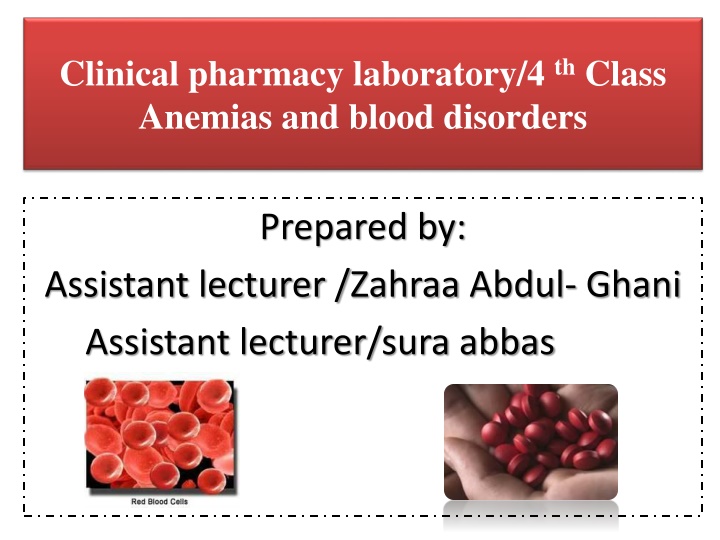
Anaemias and Blood Disorders: Treatment Overview
In this lecture on anaemias and blood disorders, the initiation of treatment, including oral and parenteral iron options, vitamins, and trace elements, is discussed. The importance of determining the type of anaemia before treatment, the rationale for iron prophylaxis, and considerations for oral iron therapy are also covered. Additionally, compound preparations and modified-release iron preparations are highlighted.
Download Presentation

Please find below an Image/Link to download the presentation.
The content on the website is provided AS IS for your information and personal use only. It may not be sold, licensed, or shared on other websites without obtaining consent from the author. If you encounter any issues during the download, it is possible that the publisher has removed the file from their server.
You are allowed to download the files provided on this website for personal or commercial use, subject to the condition that they are used lawfully. All files are the property of their respective owners.
The content on the website is provided AS IS for your information and personal use only. It may not be sold, licensed, or shared on other websites without obtaining consent from the author.
E N D
Presentation Transcript
Clinical pharmacy laboratory/4 thClass Anemias and blood disorders Prepared by: Assistant lecturer /Zahraa Abdul- Ghani Assistant lecturer/sura abbas
Lecture Outlines ORAL IRON:- Ferrous fumarate, ferrous gluconate, ferrous sulphate. PARENTERAL IRON:-iron dextran , iron sucrose , ferric carboxymaltose. Vitamins and trace elements: Folic acid , Vitamin B Preparations :Cyanocobalamin. Erythropoietin (eiopoitins): erythropoietin alfa
Anaemias Initiation of treatment Before initiating treatment for anaemia it is essential to determine which type is present. Iron salts may be harmful and result in iron overload if given to patients with anaemias other than iron deficiency type. Treatment and prophylaxis Treatment with an iron preparation is justified only in the presence of a demonstrable iron-deficiency state. Before starting treatment, it is important to exclude any serious underlying cause of the anaemia (e.g. gastric erosion, gastrointestinal cancer). Prophylaxis with an iron preparation may be appropriate in malabsorption, menorrhagia, pregnancy, after subtotal or total gastrectomy, in haemodialysis patients, and in the management of low birth-weight infants such as preterm neonates.
Oral iron Iron salts should be given by mouth unless there are good reasons for using another route. Ferrous salts show only marginal differences between one another in efficiency of absorption of iron. Haemoglobin regeneration rate is little affected by the type of salt used provided sufficient iron is given. Choice of preparation is thus usually decided by the incidence of side-effects and cost. The oral dose of elemental iron for iron-deficiency anaemia should be 100 to 200mg daily. It is customary to give this as dried ferrous sulfate; for prophylaxis of iron deficiency anaemia, ferrous sulfate may be effective. Ferrous fumarate 200 mg - Ferrous gluconate 300 mg - Ferrous sulphate 300 mg - Ferrous sulphate, dried 200 mg 65 mg iron 65 mg iron 35 mg iron 60 mg iron
Compound preparations Preparations containing iron and folic acid during pregnancy in women who are at high risk of developing iron and folic acid deficiency; they should be distinguished from those used for the prevention of neural tube defects in women planning a pregnancy. It is important to note that the small doses of folic acid contained in these preparations are inadequate for the treatment of megaloblastic anaemias. Some oral preparations contain ascorbic acid to aid absorption of the iron but the therapeutic advantage of such preparations is minimal and cost may be increased, or other ingredients, such as the B group of vitamins (except folic acid for pregnant women). are used
Modified-release preparations Modified-release preparations of iron are licensed for once daily dosage, but have no therapeutic advantage and should not be used. These preparations are formulated to release iron gradually; the low incidence of side-effects may reflect the small amounts of iron available for absorption as the iron is carried past the first part of the duodenum into an area of the gut where absorption may be poor.
Iron (oral) SIDE-EFFECTS:- Constipation . diarrhoea . epigastric pain (dose related) . faecal impaction . gastro-intestinal irritation . nausea (dose related) SIDE-EFFECTS, FURTHER INFORMATION Managing side-effects /If side-effects occur, the dose may be reduced; alternatively, another iron salt may be used, but an improvement in tolerance may simply be a result of a lower content of elemental iron. The incidence of side effects due to ferrous sulfate is no greater than with other iron salts when compared on the basis of equivalent amounts of elemental iron. Altered bowel habit Iron preparations taken orally can be constipating and occasionally lead to faecal impaction. Oral iron, particularly modified-release preparations, can exacerbate diarrhoea in patients with inflammatory bowel disease; care is also needed in patients with intestinal strictures and diverticular disease. The relationship between dose and altered bowel habit (constipation or diarrhoea) is less clear than for nausea and epigastric pain. In children Iron preparations are an important cause of accidental overdose in children and as little as 20 mg/kg of elemental iron can lead to symptoms of toxicity.
MONITORING REQUIREMENTS Therapeutic response The haemoglobin concentration should rise by about 100 200 mg/ 100mL (1 2 g/litre) per day or 2 g/100mL (20 g/litre) over 3 4 weeks. When the haemoglobin is in the normal range, treatment should be continued for a further 3 months to replenish the iron stores. PRESCRIBING AND DISPENSING INFORMATION In children Express the dose in terms of elemental iron and iron salt and select the most appropriate preparation.The most common reason for lack of response in children is poor compliance; poor absorption is rare in children. PATIENT AND CARER ADVICE Although iron preparations are best absorbed on an empty stomach they can be taken after food to reduce gastro-intestinal side-effects. May discolour stools.
Ferrous fumarate Oral solution Galfer 28mg/ml (Thornton & Ross Ltd) Capsule Galfer (Thornton & Ross Ltd) Ferrous fumarate 305 mg
Ferrous sulfate Modified-release tablet CAUTIONARY AND ADVISORY LABELS 25 Ferrograd (Teofarma) Ferrous sulfate dried 325 mg Modified-release capsule CAUTIONARY AND ADVISORY LABELS 25 Feospan Spansules (Intrapharm Laboratories Ltd) Ferrous sulfate dried 150 mg Tablet Ferrous sulfate (Non- proprietary) Ferrous sulfate dried 200 mg
Parenteral iron :-Iron dextran, iron sucrose, ferric carboxymaltose. Parenteral iron is generally reserved for use when oral therapy is unsuccessful because 1-the patient cannot tolerate oral iron, or 2-becausemalabsorption or 3- in the management of chemotherapy-induced anaemia, or 4- in patients with chronic renal failure who are receiving haemodialysis (and some who are receiving peritoneal dialysis). With the exception of patients with severe renal failure receiving haemodialysis, parenteral iron does not produce a faster haemoglobin response than oral iron provided that the oral iron preparation is taken reliably and is absorbed adequately. If parenteral iron is necessary, the dose should be calculated according to the patient s body-weight and total iron deficit. Depending on the preparation used, parenteral iron is given as a total dose or in divided doses. Further treatment should be guided by monitoring haemoglobin and serum iron concentrations. SIDE-EFFECTS :-Hypersensitivity reactions
Iron (injectable) IMPORTANT SAFETY INFORMATION:- Serious hypersensitivity reactions, including life threatening and fatal anaphylactic reactions, have been reported in patients receiving intravenous iron. These reactions can occur even when a previous administration has been tolerated (including a negative test dose). Test doses are no longer recommended and caution is needed with every dose of intravenous iron. Intravenous iron products should only be administered when appropriately trained staff and resuscitation facilities are immediately available; patients should be closely monitored for signs of hypersensitivity during and for at least 30 minutes after every administration. In the event of a hypersensitivity reaction, treatment should be stopped immediately and appropriate management initiated. The risk of hypersensitivity is increased in patients with known allergies, immune or inflammatory conditions, or those with a history of severe asthma, eczema, or other atopic allergy; in these patients, intravenous iron should only be used if the benefits outweigh the risks. Intravenous iron should be avoided in the first trimester of pregnancy and used in the second or third trimesters only if the benefit outweighs the potential risks for both mother and fetus.
Iron dextran Solution for injection Diafer (Pharmacosmos UK Ltd) A Iron isomaltoside 1000 50 mg per 1 m Monofer (Pharmacosmos UK Ltd) A Iron isomaltoside 1000 100 mg per 1 ml
Iron sucrose Solution for injection Venofer (Vifor Pharma UK Ltd, Imported (United States)) A Iron (as Iron sucrose) 20 mg per 1 ml
Ferric carboxymaltose Solution for injection ELECTROLYTES: May contain Sodium Ferinject (Vifor Pharma UK Ltd) A Iron (as Ferric carboxymaltose) 50 mg per 1 ml
Anaemias , megaloblastic Overview Most megaloblastic anaemias result from a lack of either vitamin B12 or folate, and it is essential to establish in every case which deficiency is present and the underlying cause. In emergencies, when delay might be dangerous, it is sometimes necessary to administer both substances after the bone marrow test while plasma assay results are awaited. Causes of megaloblastic anaemia : 1.in the UK is pernicious anaemia in which lack of gastric intrinsic factor resulting from an autoimmune gastritis causes malabsorption of vitamin B12. 2.Apart from dietary deficiency, all other causes of vitamin B12 deficiency are attributable to malabsorption. Hydroxocobalamin has completely replaced cyanocobalamin as the form of vitamin B12 of choice for therapy; it is retained in the body longer than cyanocobalamin and thus for maintenance therapy can be given at intervals of up to 3 months. Treatment is generally initiated with frequent administration of intramuscular injections to replenish the depleted body stores. Thereafter, maintenance treatment, which is usually for life, can be instituted. There is no evidence that doses larger than those recommended provide any additional benefit in vitamin B12 neuropathy.
vitamin B preparations - Hydroxocobalamin , cyanocobalamin, methylcobalamine
Importance of vitamin B12:- Treatment of megaloblastic anaemias It is also needed in the treatment of megaloblastosis caused by prolonged nitrous oxide anaesthesia, which inactivates the vitamin, in the rare syndrome of congenital trans cobalamin II deficiency. It should be given prophylactically after total gastrectomy or total ileal resection (or after partial gastrectomy if a vitamin B12 absorption test shows vitamin B12 malabsorption). Folic acid: Folic acid below has few indications for long-term therapy since most causes of folate deficiency are self-limiting or will yield to a short course of treatment. It should not be used in undiagnosed megaloblastic anaemia unless vitamin B12 is administered concurrently otherwise neuropathy may be precipitated. In folate-deficient megaloblastic anaemia (e.g. because of poor nutrition, pregnancy, or antiepileptic drugs), daily folic acid supplementation for 4 months brings about haematological remission and replenishes body stores. For prophylaxis in chronic haemolytic states, malabsorption, or in renal dialysis, folic acid is given daily or sometimes weekly, depending on the diet and the rate of haemolysis. Folic acid is also used for the prevention of methotrexate induced side-effects in severe Crohn s disease, rheumatic disease, and severe psoriasis. Folinic acid is also effective in the treatment of folate deficient megaloblastic anaemia but it is generally used in association with cytotoxic drugs; it is given as calcium folinate.
Folic acid Folate-deficient megaloblastic anaemia Adult: 5 mg daily for 4 months (until term in pregnant women), doses up to 15 mg. Prevention of neural tube defects Prevention of methotrexate-induced side- effects in rheumatic disease (5mg once weekly on different day of MTX)
Caution Should never be given alone for pernicious anaemia (may precipitate subacute combined degeneration of the spinal cord) SIDE-EFFECTS Abdominal distension . appetite decreased . flatulence . nausea . vitamin B12 deficiency exacerbated.
Folic acid Tablet Folic acid (Non-proprietary) Folic acid 400 microgram Folic acid 5 mg tablet Oral solution Folic acid (Non-proprietary) Folic acid 500 microgram per 1 m
Cyanocobalamin Vitamin B12 deficiency of dietary origin BY MOUTH Adult: 50 150 micrograms daily, dose to be taken between meals BY INTRAMUSCULAR INJECTION Adult: Initially 1 mg every 2 3 days for 11 doses; maintenance 1 mg every month
Hydroxocobalamin Prophylaxis of macrocytic anaemias associated with vitamin B12 deficiency BY INTRAMUSCULAR INJECTION Adult: 1 mg every 2 3 months Pernicious anaemia and other macrocytic anaemias without neurological involvement BY INTRAMUSCULAR INJECTION Adult: Initially 1 mg 3 times a week for 2 weeks, then 1 mg every 2 3 months Pernicious anaemia and other macrocytic anaemias with neurological involvement BY INTRAMUSCULAR INJECTION Adult: Initially 1 mg once daily on alternate days until no further improvement, then 1 mg every 2 months
hydroxycobalaimne PRESCRIBING AND DISPENSING INFORMATION With intramuscular use The BP directs that when vitamin B12 injection is prescribed or demanded, hydroxocobalamin injection shall be dispensed or supplied.
Side effects GENERAL SIDE-EFFECTS Diarrhoea . dizziness . headache . hot flush . nausea . Skin reactions . urine discolouration SPECIFIC SIDE-EFFECTS With intramuscular use Arrhythmia . chills . drug fever . hypokalaemia . malaise . Pain. thrombocytosis . tremor . vomiting
Solution for injection Cytamen (Focus Pharmaceuticals Ltd) Cyanocobalamin 1 mg per 1 ml Tablet Cyanocobalamin (Non-proprietary) Cyanocobalamin 50 microgram Cytacon (AMCo) Oral solution Cyanocobalamin (Non-proprietary) Cyanocobalamin 7 microgram per 1 ml
Cyano 1mg
Erythropoietins Epoetins (recombinant human erythropoietins) Darbepoetin (hyperglycosylated derivative) Methoxy polyethylene glycol-epoetin beta Erythropoietins Epoetins (recombinant human erythropoietins) are used to treat the anaemia associated with erythropoietin deficiency in chronic renal failure, to increase the yield of autologous blood in normal individuals and to shorten the period of symptomatic anaemia in patients receiving cytotoxic chemotherapy. Epoetin beta is also used for the prevention of anaemia in preterm neonates of low birth-weight; only unpreserved formulations should be used in neonates because other preparations may contain benzyl alcohol. Darbepoetin alfa is a hyperglycosylated derivative of epoetin; it has a longer half life and can be administered less frequently than epoetin. Methoxy polyethylene glycol-epoetin beta is a continuous erythropoietin receptor activator that is licensed for the treatment of symptomatic anaemia associated with chronic kidney disease. It has a longer duration of action than epoetin.
IMPORTANT SAFETY INFORMATION MHRA/CHM advice: recombinant human erythropoietins: Very rare risk of severe cutaneous adverse reactions More severe cases were recorded with long- acting agents
Erythropoietins-haemoglobin concentration Overcorrection of haemoglobin concentration in patients with chronic kidney disease may increase the risk of death and serious cardiovascular events, and in patients with cancer may increase the risk of thrombosis and related complications: patients should not be treated with erythropoietins unless symptoms of anaemia are present the haemoglobin concentration should be maintained within the range 10 12 g/100mL haemoglobin concentrations higher than 12 g/100mL should be avoided the aim of treatment is to relieve symptoms of anaemia, and in patients with chronic kidney disease to avoid the need for blood transfusion
Erythropoietinstumour progression and survival in patients with cancer Clinical trial data show an unexplained excess mortality and increased risk of tumour progression in patients with anaemia associated with cancer who have been treated with erythropoietins. Many of these trials used erythropoietins outside of the licensed indications (i.e. overcorrected haemoglobin concentration or given to patients who have not received chemotherapy): erythropoietins licensed for the treatment of symptomatic anaemia associated with cancer, are licensed only for patients who are receiving chemotherapy the decision to use erythropoietins should be based on an assessment of the benefits and risks for individual patients; blood transfusion may be the preferred treatment for anaemia associated with cancer chemotherapy, particularly in those with a good cancer prognosis
CONTRA-INDICATIONS Patients unable to receive thromboprophylaxis . pure red cell aplasia following erythropoietin therapy . uncontrolled hypertension CAUTIONS Aluminium toxicity (can impair the response to erythropoietin) . concurrent infection (can impair the response to erythropoietin) . correct factors that contribute to the anaemia of chronic renal failure, such as iron or folate deficiency, before treatment
caution epilepsy . Inadequately treated or poorly controlled blood pressure -interrupt treatment if blood pressure uncontrolled . Ischaemic vascular disease . malignant disease . other inflammatory disease (can impair the response to erythropoietin) . risk of thrombosis may be increased when used for anaemia before orthopaedic surgery avoid in cardiovascular disease including recent myocardial infarction or cerebrovascular accident . risk of thrombosis may be increased when used for anaemia in adults receiving cancer chemotherapy . sickle-cell disease (lower target haemoglobin concentration may be appropriate) . Sudden stabbing migraine-like pain (warning of a hypertensive crisis) . thrombocytosis (monitor platelet count for first 8 weeks)
Side-effects, further information Hypertensive crisis In isolated patients with normal or low blood pressure, hypertensive crisis with encephalopathy-like symptoms and generalised tonic-clonic seizures requiring immediate medical attention has occurred with epoetin. Pure red cell aplasia There have been very rare reports of pure red cell aplasia in patients treated with erythropoietins. In patients who develop a lack of efficacy with erythropoietin therapy and with a diagnosis of pure red cell aplasia, treatment with erythropoietins must be discontinued and testing for erythropoietin antibodies considered. Patients who develop pure red cell aplasia should not be switched to another form of erythropoietin.
MONITORING REQUIREMENTS Monitor closely blood pressure, reticulocyte counts, haemoglobin, and electrolytes interrupt treatment if blood pressure uncontrolled. Other factors, such as iron or folate deficiency, that contribute to the anaemia of chronic renal failure should be corrected before treatment and monitored during therapy. Supplemental iron may improve the response in resistant patients.
Epoetin alfa Symptomatic anaemia associated with chronic renal failure in patients on haemodialysis BY INTRAVENOUS INJECTION, OR BY SUBCUTANEOUS INJECTION Adult: Initially 50 units/kg 3 times a week, adjusted in steps of 25 units/kg 3 times a week, dose adjusted according to response at intervals of at least 4 weeks; maintenance 75 300 units/kg once weekly, intravenous route preferred, intravenous injection to be given over 1 5 minutes, subcutaneous injection, maximum 1mL per injection site, maintenance dose can be given as a single dose or in divided doses,
Epoetin alfa/ Solution for injection Binocrit (Sandoz Ltd) Epoetin alfa 2000 unit per 1 ml Eprex (Janssen-Cilag Ltd) Epoetin alfa 2000 unit per 1 ml NeoRecormon (Roche Products Ltd) Epoetin beta 1667 unit per 1 ml Solution for injection Mircera (Roche Products Ltd) Methoxy polyethylene glycol-epoetin beta 100 microgram per 1 ml
(Supplement) A-Food reduces amount of iron absorbed by as much as 50%. Hence, oral iron should be administered one hour before or two hours after meals for optimal absorption(2) (however iron may be taken with food if patient is unable to tolerate it) (4) B-To minimize gastric intolerance, oral iron therapy can be initiated with single oral dose of iron tablet, the dose is increased by increment of one tablet per day every two to three days until the full therapeutic dose(e.g. 1 tab t.i.d) can be administered (1) C-several products contain ascorbic acid (vitamin C) which maintain the iron in ferrous state (more absorbable form), however, a dose up to 1 gm increase iron absorption by only 10%. Lower doses of vitamin C (e.g. 100 mg) don not significantly alter iron absorption(1) D-because the rate of iron incorporation into Hb does not exceed that achieved by oral iron therapy, the response time is similar to that of oral iron therapy(1).
E-For patients with iron deficiency anemia, the replacement dose, i.e., the amount of iron dextran needed to restore hemoglobin to normal and to replete iron stores, is calculated as follows(2): Adults & patients weighing >15 kg: Dose (mg) = 0.3 x (Wt in lbs) x [100 - (Hgb x 100)/14.8] where 14.8 is normal mean Hgb. Children <15 kg: Dose = 0.3 x (Wt in lbs) x [100 - (Hgb x 100)/12] To replace blood lost on an intermittent or repetitive basis, iron dextran dose is calculated as follows: Replacement iron (mg) = blood loss in mL x hematocrit in decimal F----Z-track technique is used to avoid staining of the skin it involve(1) : 1-pull the skin laterally before injection (A). 2-inject (A). 3-release the skin to avoid back leakage of iron dextran into the dermal layer(B)
G-It is suggested that all patients considered for iron dextran injection receive a test dose of 25 mg iron (i.e. 0.5 ml). Patient should be observed for more than 1 hour for untoward (chest pain, hypotension ).if no reaction occurs, the remainder of the dose can be given. If an anaphylactic like reaction occurs, it generally responds to i.v epinephrine, diphenhydramine, and corticosteroids (3). H-not only because combination is unnecessary, but it may promote adverse reactions by saturation of the plasma portion (transferrin) binding capacity---------- so that the injected iron gives a higher unbound plasma iron conc. Than is safe(6). I-The liquid preparation of iron may be diluted with water or juice and taken through a straw to prevent staining of the teeth(4, 5).

